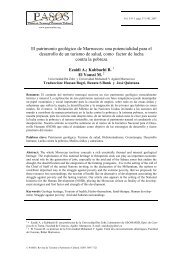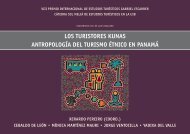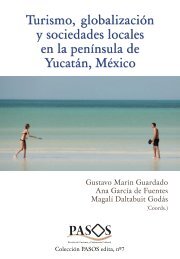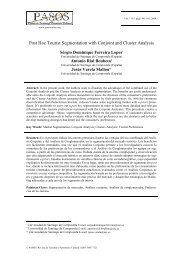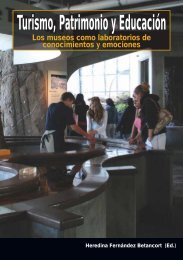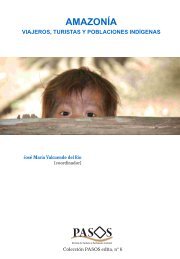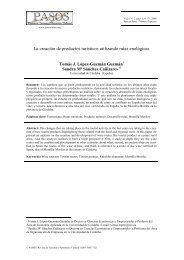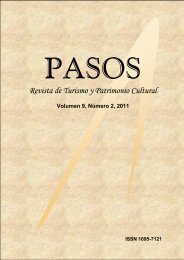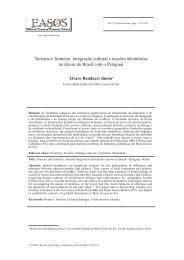Full Journal - Pasos
Full Journal - Pasos
Full Journal - Pasos
You also want an ePaper? Increase the reach of your titles
YUMPU automatically turns print PDFs into web optimized ePapers that Google loves.
Josep-Francesc Valls; Silvia Banchini; Luis Falcón; Gerard Valls Tuñon 99<br />
Figure 5: Proposed positioning<br />
4. Conclusions on and the limitations of<br />
Barcelona’s new city tourism model and<br />
internationazl competitiveness in times of<br />
crisis<br />
Barcelona’s tourism planning model over the<br />
last fifteen years has turned the city into one of<br />
the most attractive to visitors in Europe. However,<br />
its shortcomings now need to be tackled if<br />
the city is to maintain its competitiveness.<br />
Correcting this model should recognise that<br />
tourism is what is driving the city’s economy,<br />
especially in times of crisis. That is because the<br />
industry is capable of creating investment and<br />
jobs. This turns the city into a powerhouse of<br />
innovation not only in the tourism and leisure<br />
sectors but also in other city activities.<br />
The existing model does not discriminate<br />
between tourists. The proposed model clearly<br />
differentiates the city from its European competitors<br />
and both segments and seeks those<br />
who place greatest value on their experience<br />
of the city. This repositioning links Barcelona’s<br />
brand image with cultural products, lifestyle<br />
and Barcelona’s role as the capital of Catalonia.<br />
The aim is to reposition Barcelona as: a city of<br />
knowledge and innovation that draws business,<br />
entrepreneurs and top talent; a bustling metropolis<br />
attracting cruise liners and offering a wide<br />
range of city breaks.<br />
The new model requires a better share-out of<br />
public space between residents and tourists, turning<br />
both into city clients. City and tourism planning<br />
should always take into account the needs<br />
of all city clients both internal and external and<br />
the special needs and nature of its strategic<br />
external clients (in this case, ‘city break’ travellers<br />
and those spending long spells in the city for<br />
training, entrepreneurship or research purposes).<br />
The sustainability of a tourist city depends on<br />
ongoing allocation of resources. These resources<br />
must be funded by a tax levied on tourists. This<br />
will be collected by players coming into contact<br />
with visitors through some kind of publicprivate<br />
partnership, of which Barcelona already<br />
has considerable expertise.<br />
Tourism management should have a much<br />
greater impact on general planning of the city<br />
and requires better co-ordination of tasks and<br />
governance.<br />
Any task linked to urban renewal has a huge<br />
impact on many economic sectors. This needs<br />
to be taken into account in the current crisis in<br />
which unemployment is rife and consumption<br />
sluggish. The crisis has had an adverse impact<br />
on infrastructure firms, public services, public<br />
spaces, buildings and dwellings.<br />
This study has three limitations. The first<br />
concerns the benchmark weighting, which we<br />
had to invent given that there was nothing in<br />
PASOS. Revista de Turismo y Patrimonio Cultural, 11(1). 2013 ISSN 1695-7121



